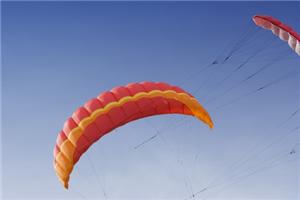Trials have begun in Germany to test whether kites can be used to generate renewable energy to power homes and businesses.
Kites could in future compete with wind turbines as a form of renewable energy, according to a Germany company developing the aerial technology.Berlin-based NTS and researchers from Fraunhofer Institute for Manufacturing Engineering and Automation IPA in Stuttgart have begun conducting trials using kites as a renewable energy source at a test site in Germany. The trials follow simulations that show a system using multiple kites could harness enough energy to power tens of thousands of homes.
“According to our simulations, we could use an NTS track running a total of 24 kites to generate 120 gigawatt hours a year (GWh/year). To put this into perspective, a two-megawatt wind turbine produces around 4 GWh/year. So an NTS system could replace 30 two-megawatt turbines and supply power to around 30,000 homes,” said Guido Lütsch, managing director of NTS.

Kites could compete with wind turbines to power homes and businesses using energy from the wind
Higher altitude winds
NTS said the benefits of using kites over wind turbines is that they can harness the power of winds at altitudes of up to 500 metres, where they exceed 20 meters a second. Such systems can also cost considerably less to build than wind turbines, which require towers each weighing hundreds of tons.
“The energy yield of a kite far exceeds that of a wind turbine, whose rotor tips turn at a maximum height of 200 metres. Doubling the wind speed results in eight times the energy,” commented Joachim Montnacher, an engineer at the Fraunhofer Institute. “Depending on wind conditions, eight kites with a combined surface area of up to 300 square meters can equate to 20 conventional one-megawatt wind turbines.”
How the technology works
The technology works by using a kite’s aerial movements to drive a generator, which in turn converts the kinetic energy into electricity.
“The kites fly at a height of 300 to 500 meters, perfectly positioned to be caught by strong winds. Cables, about 700 metres in length, tether the kites to vehicles and pull them around a circuit on rails. A generator then converts the kinetic energy of the vehicles into electricity. The control and measuring technology is positioned on the vehicles,” explained Montnacher.
NTS and the Institute have already been able to send a kite on its maiden voyage along a 400-metre-long straight track at the test site in Mecklenburg-West Pomerania.
A remote control similar to those used to fly model planes was used to manually control the kite. The experts now want to reconfigure the test track making it into a loop. Computers will eventually be used to achieve fully automatic control of the kites.